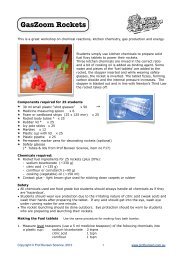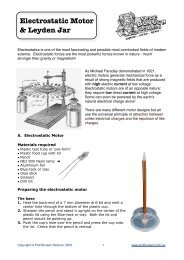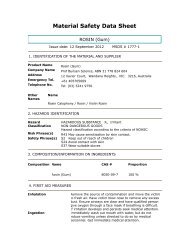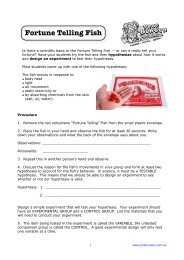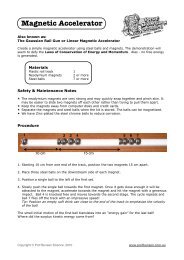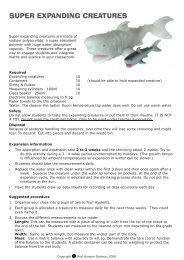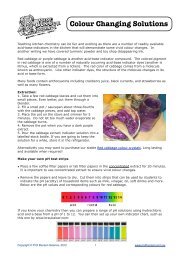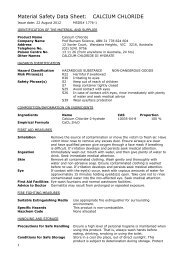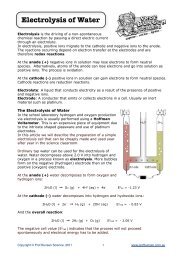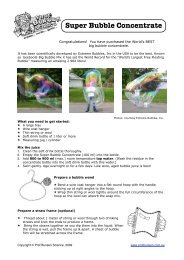A. SAFETY MESSAGES B. CONTENTS - Prof Bunsen
A. SAFETY MESSAGES B. CONTENTS - Prof Bunsen
A. SAFETY MESSAGES B. CONTENTS - Prof Bunsen
You also want an ePaper? Increase the reach of your titles
YUMPU automatically turns print PDFs into web optimized ePapers that Google loves.
D. TABLE TOP VOLCANO<br />
From the kit: volcano<br />
From the kitchen: tray, baking soda,<br />
vinegar, washing up liquid, red food<br />
colouring, teaspoon<br />
1. Place the volcano on a large flat tray<br />
to avoid making a mess. Cover the table<br />
with old newspaper. Put two teaspoonfuls<br />
of baking soda into the volcano. Add a<br />
few drops of washing up liquid and red<br />
food colouring. This will make the ‘lava’<br />
effect look more dramatic. The washing<br />
up liquid slows down the eruption and<br />
makes the volcano foam.<br />
2. Slowly pour a teaspoonful of vinegar<br />
into the volcano and watch it erupt with<br />
‘bubbly lava’.<br />
3. You can continue to add more vinegar<br />
to cause more ‘lava’ to erupt out of the<br />
volcano. Eventually the eruptions will<br />
cease.<br />
Washing<br />
up liquid<br />
1<br />
2<br />
Red food<br />
coloring<br />
Baking soda<br />
Vinegar<br />
Fun Facts<br />
Volcanoes are openings in the Earth’s surface. When they are active they can shoot<br />
out ash, gas and hot liquid rock known as magma. Once the magma comes out of<br />
the volcano, it is known as lava. Lava can flow at a rapid speed. The most lava ever<br />
recorded from a single volcanic eruption was the 1783 Laki eruption in Iceland. A<br />
quarter of the population of Iceland was killed by the poisonous gases and clouds of<br />
ash that resulted in severe destruction of crops and starvation.<br />
Below is a sectional diagram of a volcano:<br />
Ash & gas cloud<br />
Remarks: You could repeat the eruption<br />
process unlimited times. However,<br />
remember to rinse the volcano with<br />
water after each use to prevent the<br />
vinegar residual eroding the plastic.<br />
Main vent<br />
Lava<br />
Crater<br />
Side vent<br />
How does it work<br />
When the vinegar and the baking soda<br />
are mixed together, a chemical reaction<br />
takes place which produces carbon<br />
dioxide. The carbon dioxide escapes<br />
from the volcano in the form of bubbles.<br />
When all the carbon dioxide has escaped<br />
into the air, the solution becomes flat and<br />
the volcano stops ‘erupting’. You can try<br />
using lemon juice instead of vinegar and<br />
see what effect this has on the eruption.<br />
Or add some starch or sand to the baking<br />
soda to see if you can get a better ‘lava’.<br />
3<br />
Layers of ash and lava formed<br />
from previous eruptions<br />
Magma<br />
Sill<br />
4 5




